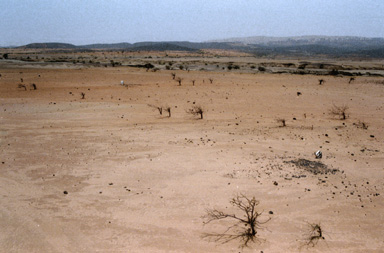DesertificationDesertification is the expansion of dry lands due
to poor agricultural practices (e.g. overgrazing, degradation of
soil fertility and structure), improper soil moisture management,
salinization and erosion, forest removal, and climate change.
BE.43 Desertification in Africa
Two common misconceptions prevail about desertification, that it spreads from a desert core and drought is responsible. Desertification spreads outward from any where excessive abuse of the land occurs and far from any climatic desert. Droughts do increase the possibility of desertification if the carrying capacity of non-irrigated land is exceeded. Well-managed land can recover from the effects of drought. Combining drought with land abuse sets the stage for desertification. Cause of DesertificationDesertification comes about by a complex interaction between the natural environment and human activities. The cause may vary from region to region on account of economic conditions, population pressure, agricultural practices, and politics. Human activities that destroys surface vegetation, degrades soil structure and fertility, impedes water infiltration, and causes soil drying promotes desertification. This is especially true for the fragile transition zone between arid and semiarid land where human activity has stretched the ecosystem to its limit causing expansion of deserts. Population growth and its demand on agricultural resources has promoted the desertification process. Over cultivation, for example, causes declining soil fertility leading to falling crop yields. Over use leads to crusting of exposed topsoil by rain and sun that increases runoff, water erosion and gullying. Soil drying promotes wind erosion and encroachment of sand dunes on arable land. Overgrazing has several effects. It:
Forest cutting for fuel wood has deforested large tracks of land in Africa and Asia encouraging desertification. Desertification around the worldThe United Nations Conference on Desertification ranks desertification hazard on the basis of a drop in agricultural productivity:
Desertification is a global problem occurring in many places but is prevalent along the margins of semiarid and arid lands in Asia, central Australia, portions of North and South America, and Africa. A world map prepared by the United States NRCS shows just how widespread the problem is.
Figure 12.44 Desertification Vulnerability Courtesy NRCS Africa has been significantly impacted by
desertification. Almost three quarters of Africa's agricultural
drylands are already degraded to some degree. The impact on
desertification on the greatest number of people occurs in Asia.
Degraded regions include the sand dunes of Syria, the eroded
mountain slopes of Nepal, and the deforested and overgrazed
highlands of Laos. The Northern Mediterranean region is the cradle
of civilization and has borne the effects of poor agricultural
practices. Salinized, infertile soils are the result of natural
hazards e.g. droughts, floods and forest fire, as well as
overtilling and overgrazing. Soil degradation is high through much
of Central and Eastern Europe, and very high in some areas, for
example along the coast of the Adriatic Sea. Poor irrigation
practices and the unsustainable exploitation of water resources are
contributing to chemical pollution, soil salinization and aquifer
depletion. Nearly a quarter of the inhabitants of Latin America and
the Caribbean live below the poverty line fueling practices that
lead to land degradation. Erosion and water shortages are
intensifying in many East Caribbean islands. |


